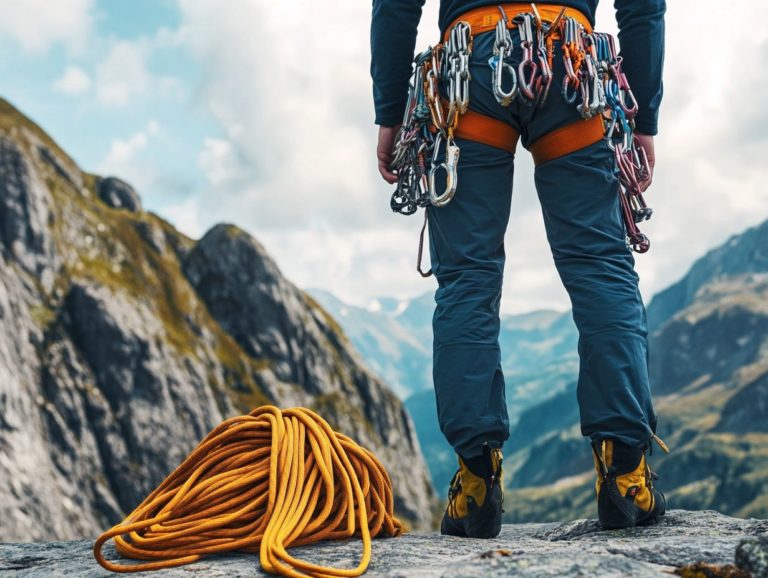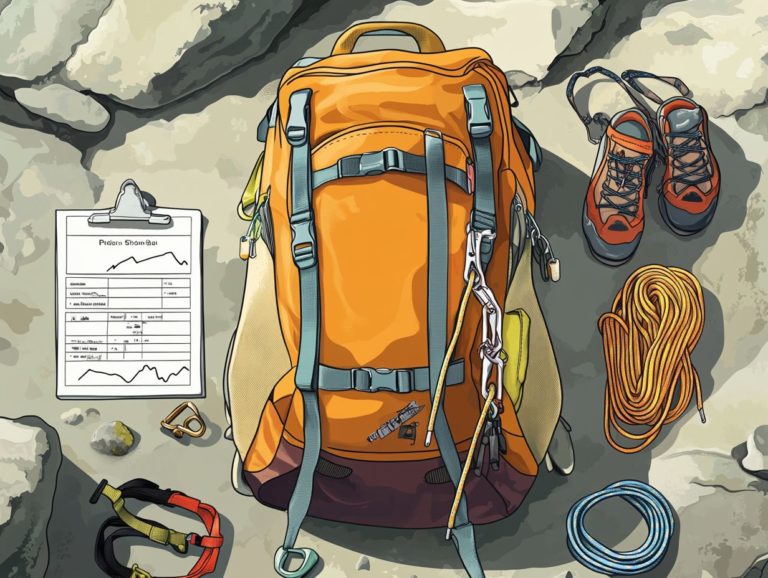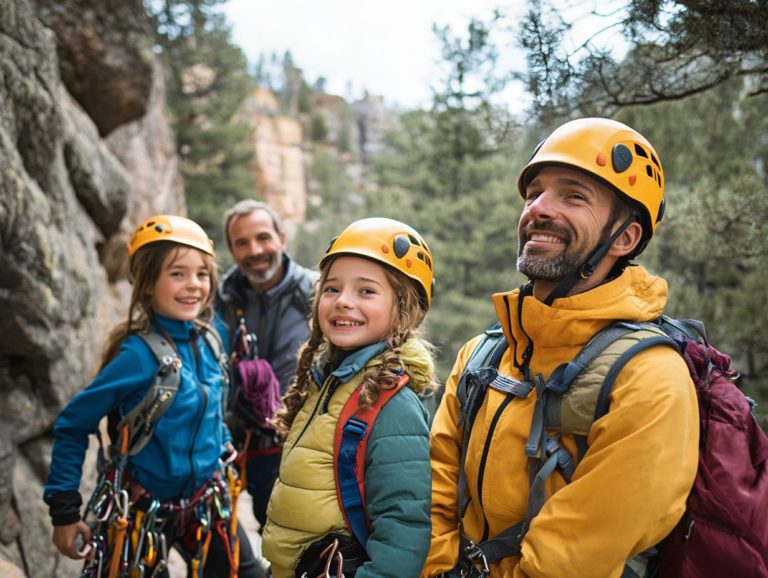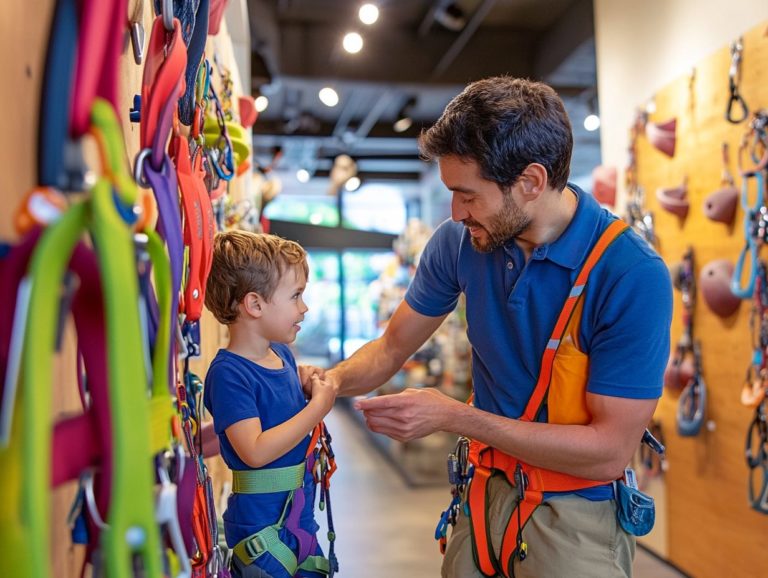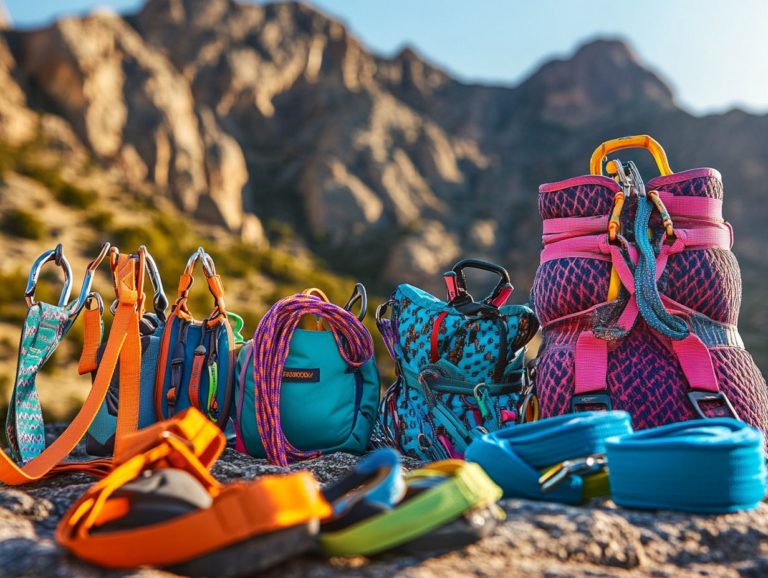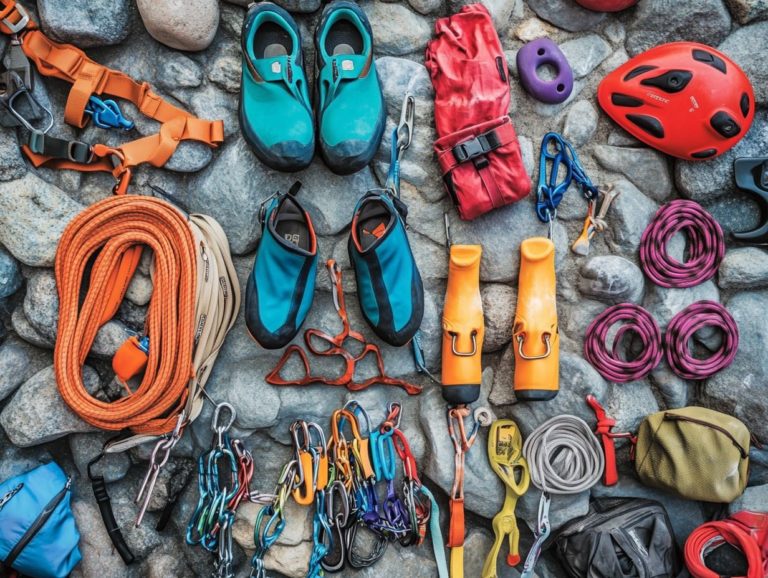Essential Gear for High Altitude Climbing
High-altitude climbing is an exhilarating adventure, but it brings its own unique challenges and risks. To ensure a safe and successful ascent, having the right gear is crucial.
This guide will walk you through the essential equipment you need, from appropriate clothing and quality hiking boots to specialized tools like ice axes and crampons. Whether you’re a seasoned climber or a novice preparing for your first expedition, knowing what to pack can make all the difference.
So, get ready to gear up for your next high-altitude challenge!
Contents
- Key Takeaways:
- 1. Proper Clothing
- 2. Quality Hiking Boots
- 3. Climbing Harness
- 4. Ice Axe
- 5. Crampons
- 6. Rope
- 7. Helmet
- 8. Sleeping Bag and Tent
- 9. Navigation Tools
- 10. First Aid Kit
- 11. Sun Protection
- 12. Water and Hydration System
- 13. High Altitude Medications
- 14. Emergency Communication Device
- 15. Portable Oxygen System
- Frequently Asked Questions
- What is essential gear for high altitude climbing?
- Do I need specialized gear for high altitude climbing?
- Why do I need an ice axe for high altitude climbing?
- What type of clothing is necessary for high altitude climbing?
- Can I rent gear for high altitude climbing?
- Why do I need a tent for high altitude climbing?
Key Takeaways:
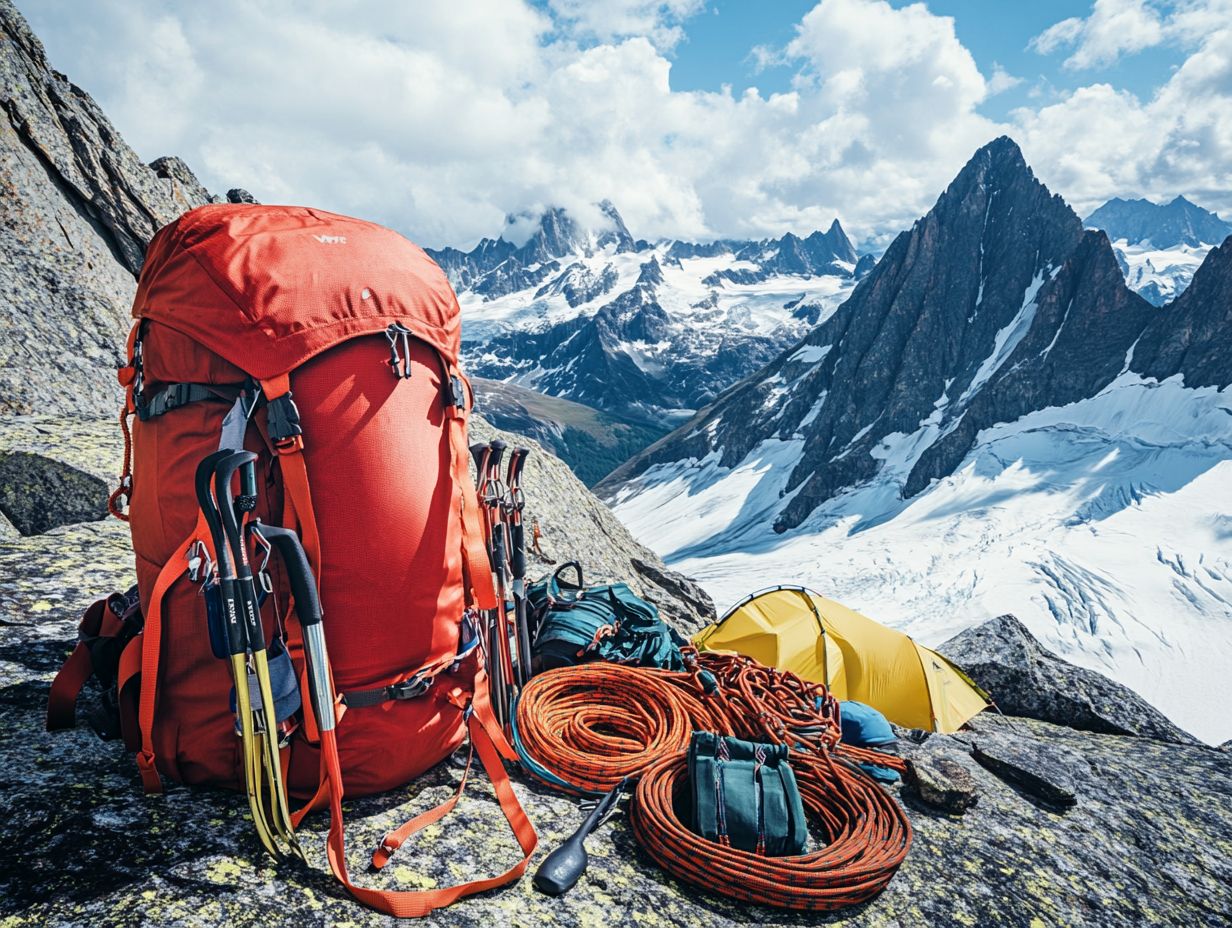
- Proper clothing is essential for high-altitude climbing. Wear layers for temperature changes and protection from harsh weather.
- Quality hiking boots are necessary for support and traction on rocky terrain. This reduces your risk of injuries.
- Climbing harnesses provide safety and support. They allow full use of hands and greater mobility during steep climbs.
1. Proper Clothing
Choosing the right clothing for your Denali expedition is crucial. It helps ensure your gear keeps you safe in the cold.
Invest in insulation layers like Smartwool, Patagonia Grade VII, and Mountain Hardwear. Smartwool s wool keeps your skin dry, while Patagonia s jackets are warm without bulk.
Mountain Hardwear s offerings combine wind-resistant materials with lightweight insulation. Using a layering system helps you adjust to fluctuating temperatures, ensuring each piece of gear works in perfect harmony.
This way, you can focus on the ascent rather than fighting against the elements.
2. Quality Hiking Boots
You can t take on Mount Denali without top-notch boots like the Scarpa Phantom 6000! These boots provide the needed support and warmth for tough conditions.
They keep your feet warm, dry, and supported. With robust insulation and advanced waterproofing, they re built for freezing temperatures and wet conditions.
These boots enhance grip on rocky surfaces and provide unparalleled comfort during long climbs, allowing you to focus entirely on your ascent.
3. Climbing Harness
A climbing harness is crucial for your safety during climbs. It connects you securely to your gear and protects you from falls.
You ll find various harnesses tailored for different climbing styles. A lightweight option is ideal for alpine climbing, while a sturdier design suits multi-pitch routes.
By understanding each climbing environment, you can select the perfect harness, enhancing both functionality and your peace of mind on the climb.
4. Ice Axe
An ice axe is essential for any mountaineering expedition, especially in challenging climbing environments like Denali, where stability and safety are non-negotiable on icy slopes. The ice axe is a crucial tool that could save your life!
You’ll find various types of ice axes designed to cater to different climbing styles and conditions. For instance, a classic mountaineering axe boasts a straight shaft and a curved pick, making it ideal for glacier travel. In contrast, a technical ice axe may feature a more pronounced curve and a lightweight design, perfect for tackling steep ice routes.
When selecting the right ice axe, consider the specific requirements of your expedition, including the terrain, altitude, and your own proficiency level.
Ultimately, the ice axe not only acts as a crucial tool for self-arrest, which means stopping yourself from sliding down icy slopes, and protection against falls but also helps you maintain balance during precarious ascents. It’s a vital component of any climber s gear.
5. Crampons
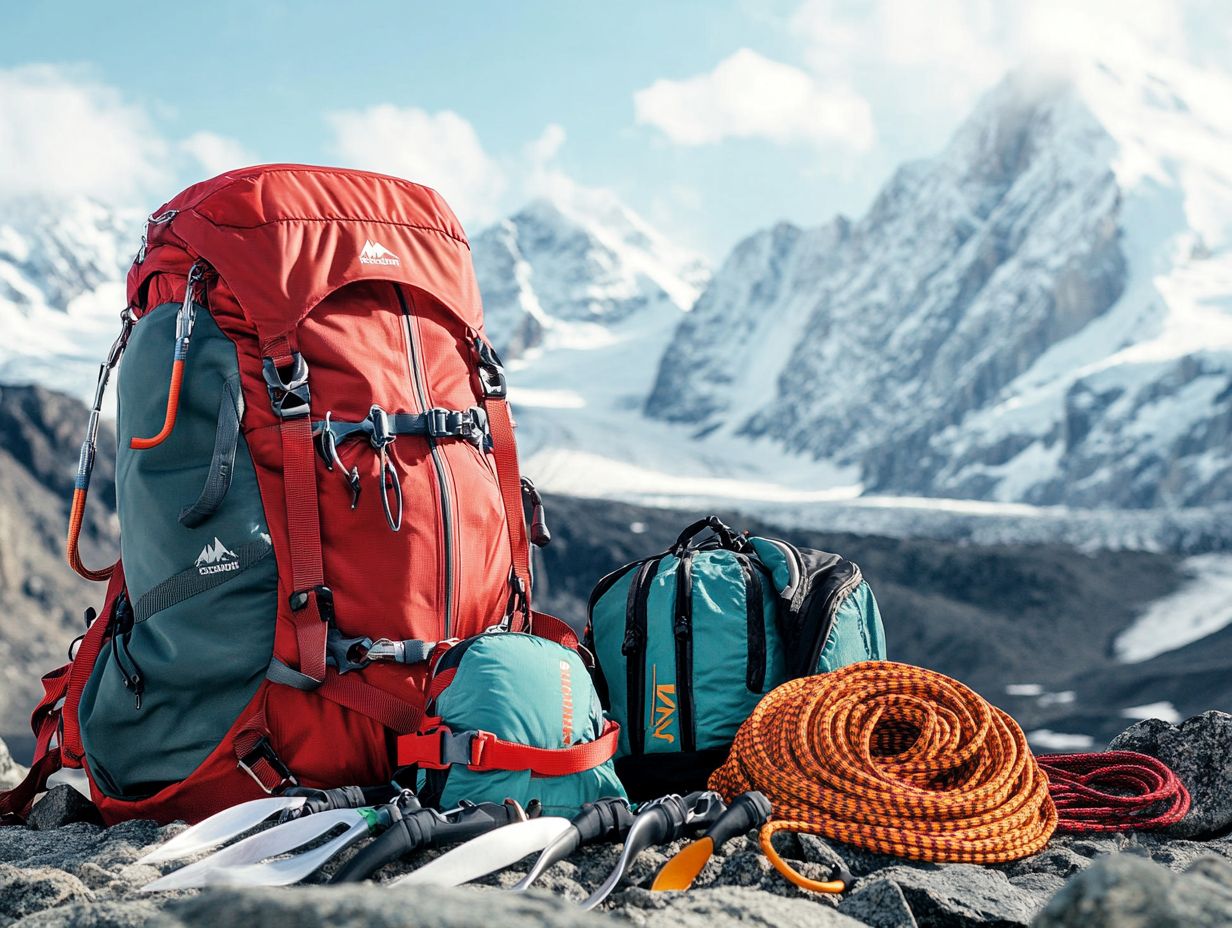
Crampons are essential for your mountaineering endeavors, providing the traction you need on icy surfaces and steep gradients, especially in high-altitude environments like Denali. These spikes are crucial for gripping ice and snow!
Their design can vary widely, with different materials and configurations tailored for specific activities. You might choose from lightweight models that excel in technical climbs to more robust options built for mixed conditions, including the best survival gear for high altitude.
Each type offers distinct characteristics, such as the number of points, which significantly influence your stability and grip. For example, modular crampons give you the power to adapt your gear to changing terrain or weather, enhancing both your safety and performance.
When selecting the right type, think about the climbing conditions you ll face as well as your personal preferences. This ensures that the crampon you choose perfectly complements your overall mountaineering experience.
6. Rope
In mountaineering, having a sturdy rope is not just a nice-to-have; it s essential for technical climbing. It serves as your safety line while you navigate challenging routes and hazardous conditions.
Understanding the different types of climbing ropes can significantly enhance your safety and performance during expeditions. Ropes generally fall into two categories: dynamic and static. Dynamic ropes are made from elastic materials and are designed to absorb the impact of a fall. Static ropes, made from less stretchy materials, are best for situations where minimal elongation is needed, like rappelling or hauling gear.
The thickness of these ropes plays a crucial role in your climbing experience. Thicker ropes often provide greater durability and grip but can add extra weight to your pack. The rope’s durability, determined by its materials and construction, is vital for withstanding wear and weather conditions, ultimately ensuring your security on demanding ascents.
7. Helmet
A helmet is an essential piece of gear in mountaineering, serving as a crucial safety measure to shield you from falling debris and impacts during technical climbs. Don’t hit the mountain without it!
Selecting the right helmet is more than just picking a protective shell; it involves understanding features like comfort, fit, and ventilation, all of which can significantly elevate your climbing experience. A well-fitting helmet should feel just right not too tight, not too loose.
It should sit securely on your head without causing discomfort, allowing you to concentrate on your ascent rather than constantly adjusting your gear. Ventilation plays a key role as well. Good airflow helps to reduce heat buildup, especially during those strenuous climbs. Additionally, having the right essential survival gear for mountain adventures can significantly enhance your experience.
These thoughtful features not only ensure your comfort but also enhance your overall safety, enabling you to stay alert and at ease, which ultimately boosts your performance in challenging situations. Make sure you choose the right helmet before your next climb!
8. Sleeping Bag and Tent
Selecting the right sleeping bag and tent is essential for warmth and comfort during your mountain climbing adventures, especially in the frigid conditions of Denali.
In such cold environments, insulation is critical. Choose options like down-filled sleeping bags from reputable brands if you value a restful night’s sleep. For example, Feathered Friends sleeping bags offer impressive warmth-to-weight ratios, keeping you cozy even in extreme temperatures.
The 40 Below K2 withstands the harshest winter conditions, providing insulation and exceptional durability. Pair these high-quality sleeping bags with a sturdy tent that has reinforced seams and weather-resistant materials for improved protection against relentless winds and snowfall. For those venturing into the mountains, it’s also crucial to invest in survival gear for mountain climbing. This combination paves the way for a successful mountain climbing experience.
In the vast wilderness of Alaska, good navigation tools are essential. They help you traverse rugged terrains and handle unpredictable weather safely.
With options from traditional compasses to detailed topographic maps, you can chart your course confidently while soaking in the breathtaking landscapes. Modern GPS devices provide real-time location data for precise route planning.
However, even the best tools can’t replace reliable communication devices like the InReach. This gadget lets you share your location with loved ones and offers a safety net through two-way messaging and emergency SOS capabilities. In the most remote areas, help is just a click away.
10. First Aid Kit
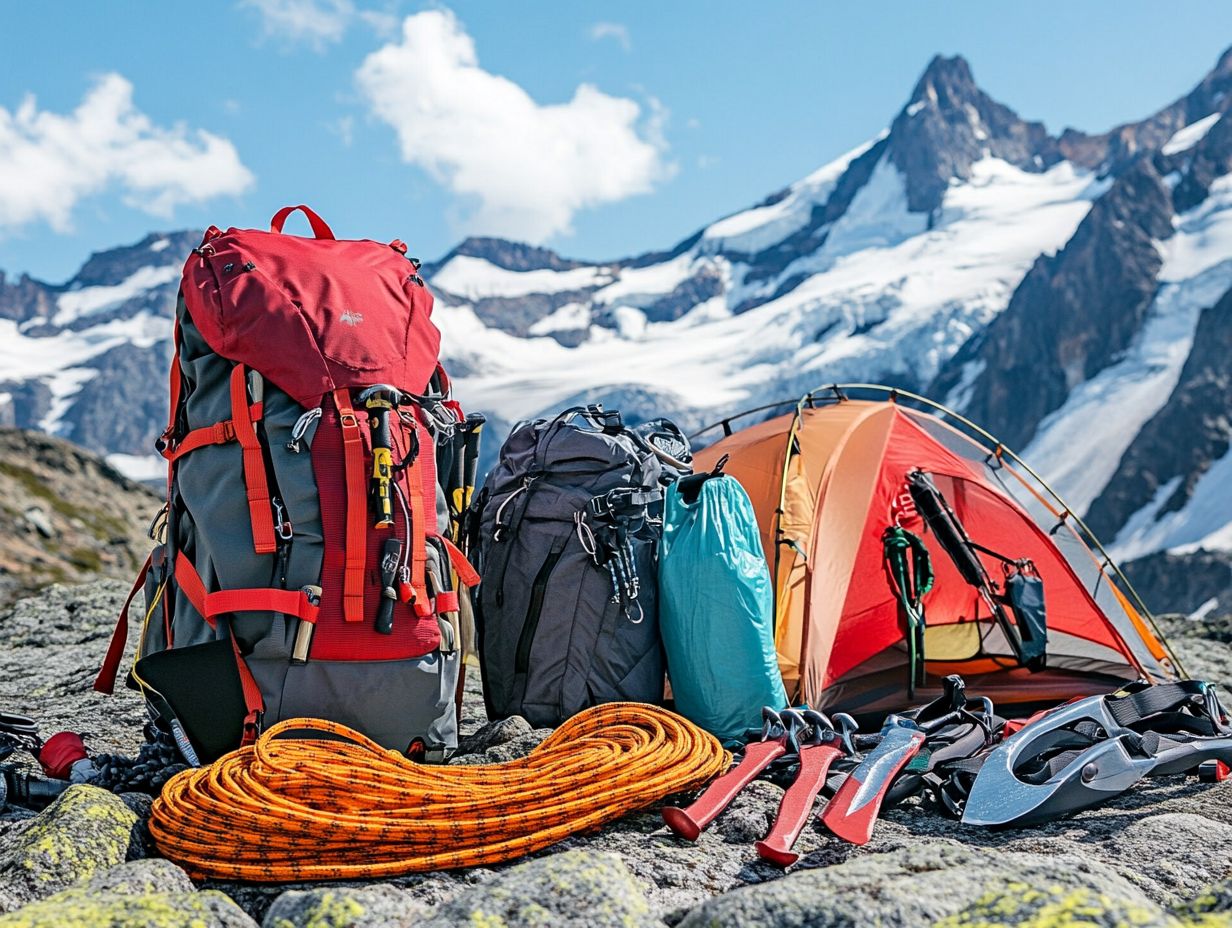
A well-stocked first aid kit is essential for your mountain climbing expeditions. It prepares you for potential injuries and emergencies in the unpredictable wilderness of Denali.
Given the treacherous terrain and extreme weather at high altitudes, equip yourself with supplies to manage everything from altitude sickness (feeling sick due to high elevations) to frostbite (skin damage from extreme cold). For your journey, consider packing essential gear for winter camping adventures. Essential items should include:
- Pain relievers to help manage discomfort.
- Antiseptic wipes for cleaning wounds.
- Supplies for wound management to treat injuries.
- Medication for altitude-related ailments to combat sickness.
It’s vital to include gear that can immobilize fractures. Evacuating an injured team member carries significant risks. Being prepared with the right tools enhances your safety and boosts your confidence in facing nature’s challenges head-on.
11. Sun Protection
Effective sun protection is vital for you as a mountaineer, especially in high-altitude environments where UV exposure, or harmful rays from the sun that can damage your skin, is heightened, even in chilly weather.
As you ascend rugged peaks or navigate snow-covered terrains, the threat of ultraviolet radiation is serious and requires your attention. Combat this risk with a multi-faceted approach to sun protection, which includes:
- Applying broad-spectrum sunscreen with a high SPF to all exposed skin,
- Wearing sunglasses with UV protection to shield your eyes,
- Choosing clothing made from UV-blocking fabrics for added defense.
These protective measures are increasingly vital during extended outdoor activities, as unprotected exposure can lead to skin damage, premature aging, and eye injuries. By prioritizing comprehensive sun protection, you can enjoy the breathtaking beauty of nature while ensuring your well-being.
Are you ready for your adventure? Equip yourself right and conquer those peaks with confidence!
12. Water and Hydration System
In mountaineering, maintaining proper hydration is essential for your performance and safety. A reliable water and hydration system is critical for your expeditions.
You have various hydration systems at your disposal, including water bottles, hydration packs, and reservoirs. Each option has its unique advantages and disadvantages.
For instance, hydration packs provide hands-free access to water and can hold a generous amount of fluid, beneficial during long treks. However, they can also be cumbersome and tricky to clean.
On the other hand, traditional water bottles are less bulky and easier to refill, but they may require more frequent stops.
In challenging environments where water sources might be scarce or contaminated, it’s wise to carry extra supplies like water purification tablets or filters. This ensures a healthy and sufficient water supply, regardless of the conditions you encounter.
13. High Altitude Medications
High altitude medications are essential for preventing and managing altitude sickness, which poses serious risks during your expeditions.
Medications like acetazolamide, dexamethasone, and ibuprofen help you get used to high altitudes and alleviate symptoms from sudden elevation increases. Acetazolamide, in particular, promotes faster acclimatization and reduces the likelihood of serious conditions like High Altitude Pulmonary Edema (HAPE) and High Altitude Cerebral Edema (HACE), which are fluid buildup in the lungs and brain, respectively. For those planning alpine climbs, having the right equipment is crucial; check out the best climbing gear for alpine climbs to ensure you’re well-prepared.
Understanding the right timing and dosage of these medications is crucial since their effectiveness depends on proper use. As you venture into high altitudes, educate yourself on these options. Additionally, having the essential gear for ice climbing adventures can enhance your overall experience. Balance medication use with your body’s natural adjustment process to ensure a safe and enjoyable experience.
14. Emergency Communication Device
An emergency communication device, like the InReach, is essential for your safety during mountaineering. It allows you to send alerts and updates even in the most remote areas.
These devices offer features like two-way messaging, GPS tracking, and weather updates. They are critical tools for anyone tackling high-altitude climbs.
With a reliable connection to rescue services, you can embark on your adventure with greater peace of mind, knowing help is just a message away, regardless of how far you are from civilization.
The ability to share your location in real-time enhances personal safety and boosts group dynamics by keeping fellow climbers informed about each other’s whereabouts. Embracing this technology elevates your climbing experience, allowing you to focus more on the journey rather than emergency situations. Additionally, understanding what gear you need for snow climbing is also crucial for a successful adventure.
15. Portable Oxygen System
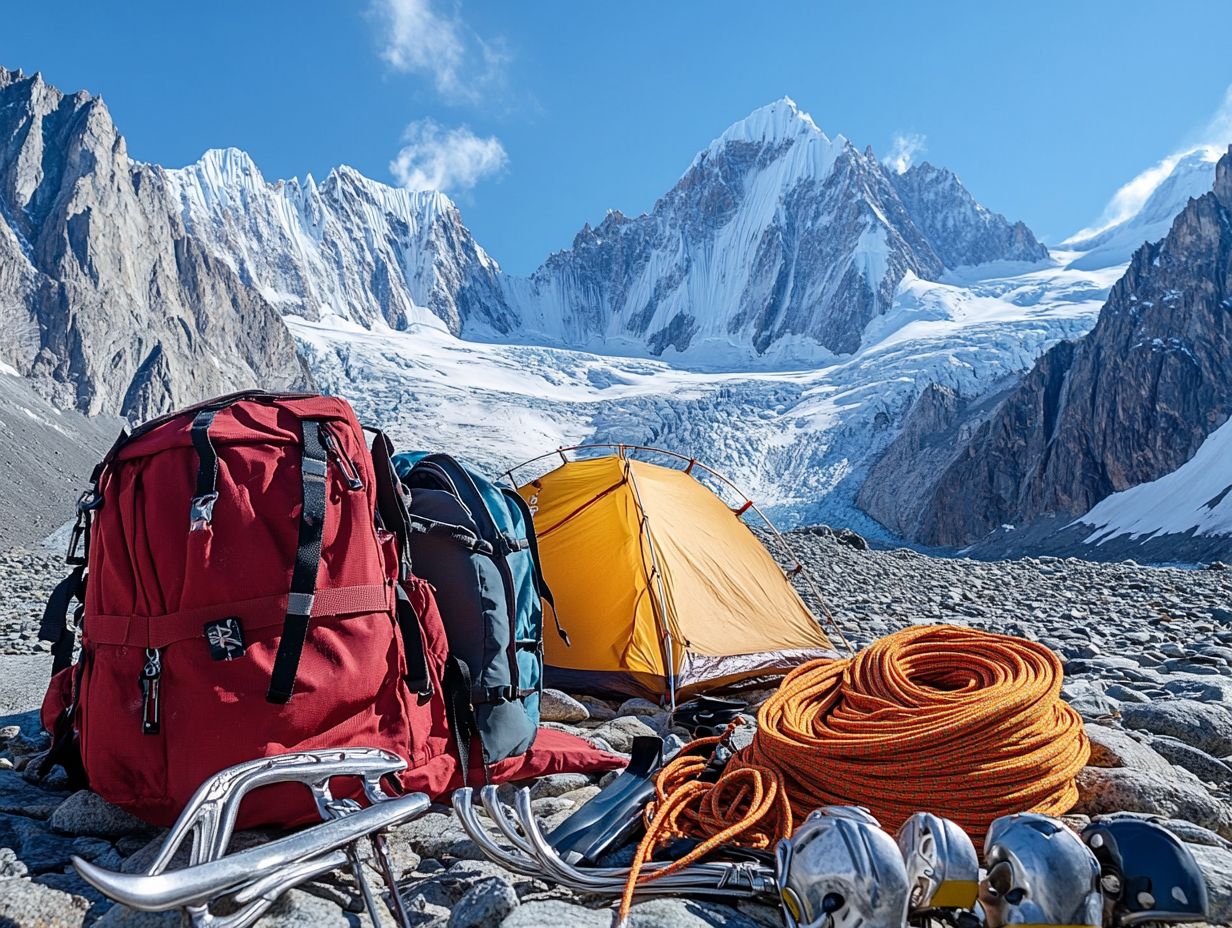
A portable oxygen system is often critical for your high-altitude expeditions. The thin air can lead to severe altitude sickness and impact your performance.
For climbers venturing above 8,000 meters, the advantages of these systems become even more significant. They deliver essential supplemental oxygen, allowing you to sustain both your physical and cognitive functions despite the lower atmospheric pressure. Additionally, having the right gear for winter hiking can enhance your overall safety and performance in such extreme conditions.
It’s not just about carrying the equipment; you also need to know how to adjust the oxygen flow for your needs and the ever-changing conditions. Before your climb, take the time to familiarize yourself with the system’s mechanics, and ensure you have the top climbing gear for rock climbers to support your adventure.
Being prepared can make all the difference when every breath counts! Strategic planning on when and how to use this life-saving resource can dramatically increase your chances of a successful ascent and empower you to tackle daunting peaks with renewed confidence.
Frequently Asked Questions
What is essential gear for high altitude climbing?
Essential gear for high altitude climbing includes items such as an ice axe, crampons, harness, helmet, and warm, waterproof clothing. Other important gear includes a tent, sleeping bag, and cooking supplies.
Don t risk it! Always be prepared for the unexpected by gathering the necessary gear before your next mountaineering adventure.
Do I need specialized gear for high altitude climbing?
Yes, you need specialized gear for high altitude climbing. Regular hiking gear isn t suitable for these harsh conditions.
Why do I need an ice axe for high altitude climbing?
An ice axe is crucial for stability on snow or ice. It can also help you stop a fall if you slip.
What type of clothing is necessary for high altitude climbing?
You need warm, waterproof clothing. A down jacket, insulated pants, and waterproof gloves are essential.
Can I rent gear for high altitude climbing?
Yes, gear rental is available from many outdoor companies. However, owning your own gear ensures comfort and familiarity.
Why do I need a tent for high altitude climbing?
A tent provides shelter and protects you from harsh weather. It s also a comfortable spot to rest and recover.

